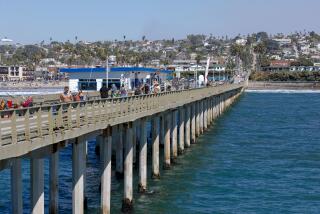Panel OKs Dredging of Marina : Waterways: Coastal Commission reverses rejection of Marina del Rey plan after Army Corps of Engineers promises to seek long-term solutions.
- Share via
The California Coastal Commission agreed Tuesday to allow tons of contaminated silt and sand to be dredged from the entrance of Marina del Rey--but only after securing assurances that the Army Corps of Engineers will develop long-term solutions to keep the channel clear.
The 11-0 vote reverses the commission’s rejection last month of the corps’ plan to remove as much as 135,000 cubic yards of material, encase it in plastic and dump it in Los Angeles Harbor as part of a port expansion project. The dredging will be completed by Dec. 1.
Although still expressing concern about the environmental consequences of the dredging, commissioners concluded that the silt and sand--which contains lead and other contaminants--will be far less hazardous than other fill being poured into Los Angeles Harbor.
Commissioners shifted gears after being warned that the marina’s waterways are becoming perilously shallow and must be deepened to keep them open to recreational boaters and the Coast Guard, which maintains an air-sea rescue headquarters in the marina.
“It . . . is urgent to open up the marina,” Dorothy Soule a professor of marine biology at USC, told commissioners. “You must take as much out of there as you can, as fast as you can.”
For years, the Corps of Engineers has periodically dredged the marina to keep its main channel clear of untold tons of material deposited by nearby Ballona Creek. The creek drains a 126-square-mile area from Downtown Los Angeles to the Pacific Ocean.
But with the increasing discovery of contaminated materials, the dredging has run afoul of many public agencies and environmental organizations, including Heal the Bay. In public hearings and private communications, they have raised objections not only to where the contaminated material will be dumped, but what long-term solutions are being developed to reduce the runoff from Ballona Creek. As much as 10 billion gallons of creek water a day can flow into the sea during heavy rains.
The criticism of the corps’ efforts led to last month’s commission decision to reject the dredging project, estimated to cost no more than $500,000.
But after its plan was rejected, the corps resubmitted the proposal with some significant changes, said Mark Delaplaine who presented the commission’s staff report at Tuesday’s meeting.
Most notably, Delaplaine said, the corps agreed to immediately investigate other long-term solutions to the dredging and disposal problems at Marina del Rey. The federal agency signed an agreement that commits it to developing a workable plan to preserve the channel in conjunction with other agencies, including the Coastal Commission and county Department of Beaches and Harbors.
“The key was reaching an agreement to sit down and talk,” Delaplaine said after the vote.
The agreement led several former critics of the project, among them Los Angeles City Councilman Rudy Svorinich Jr., to temper their opposition while a final plan is developed.
Some remained skeptical that the dredging will do anything more than transfer contaminated soil from one coastal site to another.
“We’re concerned about the adequacy of the monitoring” of San Pedro Bay, said Greg Smith, president of the Point Fermin Homeowners Assn. “At worst, this project could become a monstrous new Superfund site.”
Dredging advocates acknowledged that the project is only a stopgap measure--and one that could prove nearly futile if winter rains swell Ballona Creek.
“We are hoping we will not have catastrophic flooding . . . that we will be OK for a couple of years” with the dredging, said the corps’ Col. Michal R. Robinson. “But . . . we are subject to the whims of nature.”
More to Read
Sign up for Essential California
The most important California stories and recommendations in your inbox every morning.
You may occasionally receive promotional content from the Los Angeles Times.










